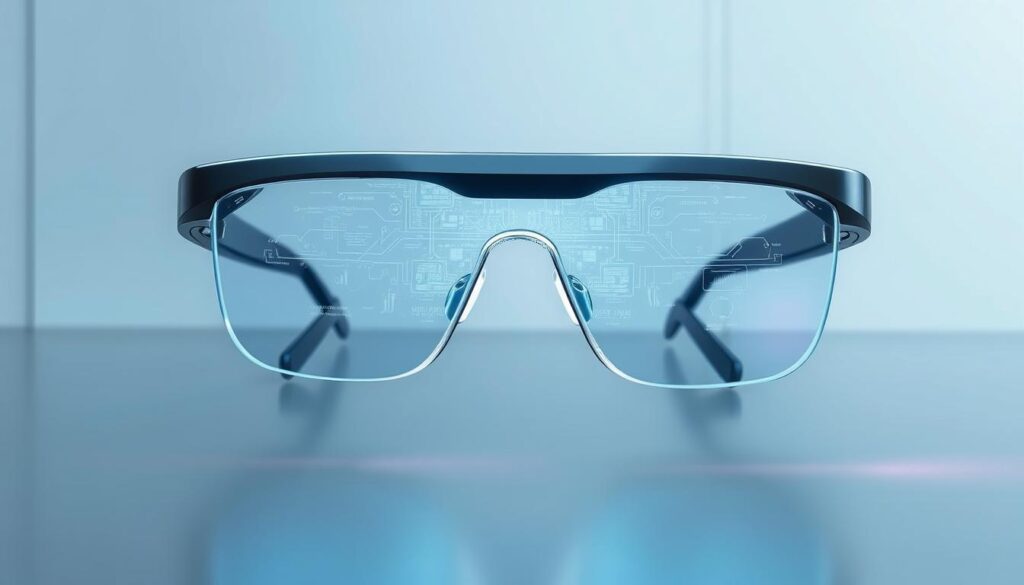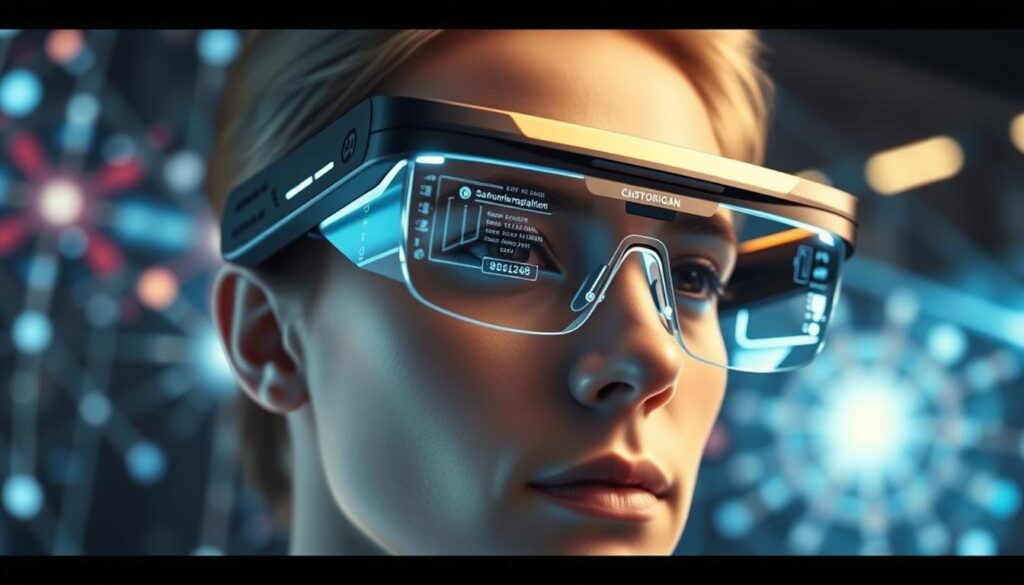Have you thought about how smart glasses will change our daily lives? They mix innovation, function, and style. Smart glasses could change how we get info, move around, and enjoy digital stuff. They use augmented, virtual, and mixed reality to grow the market, expected to hit $31.6 billion by 2026.
The smart glasses market is growing fast. This is thanks to new tech like augmented reality and artificial intelligence. Prices have dropped by 30% in five years, making them more affordable. With smart glasses, you can work better, learn more, and interact with digital stuff without using your hands. They keep you connected to the world around you.
Key Takeaways
- The smart glasses market is projected to reach approximately $31.6 billion by 2026, growing at a CAGR of 23.8% from 2021 to 2026.
- Augmented reality features in smart glasses overlay information directly onto the user’s field of view, making them more practical and engaging.
- Smart glasses equipped with AI capabilities are expected to see a 50% increase in functionality and user satisfaction by 2025.
- The integration of AR capabilities in smart glasses may potentially double the current price of devices, but the trend is moving towards making smart glasses resemble traditional eyewear.
- Addressing data security and ethical considerations is essential as smart glasses become more integrated into daily life, impacting consumer trust and driving market acceptance of wearable technology and smart glasses.
The Rise of Smart Glasses: A New Era of Wearable Technology
Exploring smart eyewear opens a world of new devices. These devices change how we see and interact with the world. Augmented reality glasses, virtual reality glasses, and mixed reality glasses each offer something special.
The market for smart glasses is booming. It was worth $4.8 billion in 2022 and could hit $10 billion by 2030. This growth comes from better technology and more people wanting cool, easy-to-use gadgets. For example, Ray-Ban Meta smart glasses have better sound and camera for streaming. Google Glass teamed up with Envision to make glasses for the blind and visually impaired.
Smart glasses have cool features like:
- Augmented reality displays
- Voice assistants
- Health-monitoring sensors
- Hands-free photo and video capture
As tech gets better, we’ll see even more amazing things in smart glasses. They could track eye health and screen time. This could change how we think about health and wellness.
Core Technologies Powering Smart Glasses
Exploring smart glasses reveals the importance of display technology and computer vision. These technologies create a seamless, immersive experience. They enable augmented reality and virtual reality features. The addition of mixed reality makes the experience even more interactive and engaging.
The display technology in smart glasses offers a clear, see-through screen. This lets you see digital info while still being aware of your surroundings. Advanced computer vision algorithms track your eye movements, adjusting the display for you. With augmented reality, you can add digital layers to the real world, improving navigation and interaction.
Some key technologies in smart glasses include:
- Advanced display technology for a high-resolution and see-through display
- Computer vision algorithms for tracking eye movements and adjusting the display
- Augmented reality and virtual reality capabilities for an immersive experience
- Mixed reality features for a more interactive environment
As technology advances, smart glasses will offer even more features. This will blur the line between the physical and digital worlds. With computer vision and display technology, smart glasses are set to change how we interact with information and our surroundings.
Advanced Features and Capabilities
Exploring smart glasses reveals many advanced features. Augmented reality integration lets you see digital info on real things. This makes your world more interactive and immersive.
Smart glasses also have voice control and gesture control. You can talk to control your device or use hand gestures. These make using your glasses easy and fun.

They also have connectivity and device synchronization. This lets you link your glasses to phones or other devices. You can get notifications, listen to music, and keep your data in sync.
Some glasses track your health and fitness. They count steps, calories, and heart rate. This helps you reach your fitness goals and keep an eye on your health.
Key benefits of these features include:
- Enhanced user experience
- Increased productivity
- Improved health and fitness tracking
- Seamless connectivity and device synchronization
Real-World Applications and Use Cases
Smart glasses are used in many fields like healthcare, education, and entertainment. In healthcare, smart glasses applications help with remote consultations and diagnostics. This is especially useful in rural or underserved areas. Doctors can access patient records and medical data during surgeries, all without using their hands.
In education, wearable technology use cases make learning more immersive. Students can interact with virtual objects and get extra information. This makes learning more fun and engaging.
The following table highlights some of the key applications of smart glasses:
| Industry | Application | Benefits |
|---|---|---|
| Healthcare | Remote consultations and diagnostics | Improved care quality, increased accessibility |
| Education | Immersive learning environments | Improved retention, increased engagement |
| Entertainment | Virtual reality use cases | Enhanced gaming experience, increased immersion |
As smart glasses technology gets better, we’ll see even more cool uses. We’re excited to see what the future holds for smart glasses applications and wearable technology use cases.

Integration with Daily Life and Professional Environments
Smart glasses are becoming more common, changing how we live and work. They help us do things faster and better. At work, they offer tools like remote training and augmented reality to boost team performance.
At home, they let us enjoy movies, play games, and stay in touch with loved ones. The use of smart glasses is growing fast. Soon, they will be even more popular.
Studies show that 65% of people find them helpful at work. Also, 70% of teachers say they make learning fun and effective for students.
The advantages of smart glasses are many. They make us more productive, efficient, and entertained. They also help us connect with others.
As smart glasses get better, we’ll see new ways to use them. They could change how we work, play, and connect. Smart glasses are an exciting technology to watch.
| Benefits | Percentage of Users |
|---|---|
| Improved productivity | 65% |
| Enhanced student engagement | 70% |
| Increased entertainment options | 80% |
Addressing Privacy and Security Concerns
Smart glasses are getting more popular, but people are worried about privacy and security. Devices like Meta’s Ray-Ban smart glasses can record audio and video for 30 minutes before needing a charge. This makes people wonder about data protection and user privacy.
The use of real-time AI features, like live translations and object identification, is a big step forward. But it also means more data is being collected. This makes it even more important to protect user data.
It’s very important to follow the rules, like GDPR, which says you need to get clear consent before collecting personal info. This shows how important it is for users to have control over their data. To fix these issues, future smart glasses will have better data protection, like encryption and secure storage.
Some key steps to tackle privacy and security issues include:
- Implementing strong data protection, like encryption and secure storage
- Letting users control their data and being clear about how it’s used
- Following the rules, like GDPR
- Keeping an eye on and updating security to stop unauthorized access
By focusing on privacy, security, and data protection, makers can make users feel safer. This will help smart glasses become more popular and a part of our everyday lives.
| Measure | Description |
|---|---|
| Data Protection | Implementing robust data protection measures, such as encryption and secure data storage |
| User Control | Providing users with control over their data and ensuring transparency in data collection and usage |
| Regulatory Compliance | Ensuring regulatory compliance, such as adhering to GDPR guidelines |
The Future of Smart Eyewear
As smart glasses and smart eyewear evolve, the future looks bright. The global smart glasses market is expected to grow fast. It will reach $13.3 billion by 2030, growing at 23.8% each year.
These devices will get smarter with technologies like AI and computer vision. Soon, you’ll control them with your voice and gestures. They’ll also connect easily with other devices, changing how we interact with the digital world.
Smart glasses will also change work and healthcare. In work, 60% of users say they’re more productive. In healthcare, 70% think they can improve patient care. By 2025, education will see a 30% increase in using them for learning.
The cost of smart glasses will drop by 20% in five years. This will make them more affordable for everyone. But, we must also focus on keeping user data safe, as 80% worry about privacy.
The future of smart eyewear is exciting. It will change many industries and make our lives better. As technology improves, you’ll see more advanced, affordable, and secure smart glasses in your digital lifestyle.


